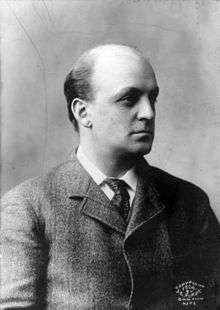William Cameron Forbes
| William Cameron Forbes | |
|---|---|
 | |
| Governor General of the Philippines | |
|
In office November 11, 1909 – September 1, 1913 | |
| Preceded by | James Francis Smith |
| Succeeded by | Newton W. Gilbert (acting) |
| 1st President of the Philippine Amateur Athletic Federation | |
|
In office 1911–1916 | |
| Succeeded by | Manuel L. Quezon |
| Personal details | |
| Born |
William Cameron Forbes May 21, 1870 |
| Died | December 24, 1959 (aged 89) |
William Cameron Forbes (May 21, 1870 – December 24, 1959) was an American investment banker and diplomat. He served as Governor-General of the Philippines from 1909 to 1913 and Ambassador of the United States to Japan from 1930 to 1932.
He was the son of William Hathaway Forbes, president of the Bell Telephone Company, and wife Edith Emerson, a daughter of Ralph Waldo Emerson, nephew of James Grant Forbes and grandson of Francis Blackwell Forbes. After graduating from Harvard in 1892, he embarked on a business career, eventually becoming a partner in J. M. Forbes and Company.[1]
Philippines
During the administration of President William Howard Taft, Forbes was governor-general of the Philippine from 1909 to 1913.[2] Previously, during the administration of President Theodore Roosevelt, he had been Commissioner of Commerce and Police in the American colonial Insular Government of the Philippines from 1904 through 1908; and he was Vice Governor from 1908 through 1909.[1] As modest legacy from those years of service in Manila, the gated community of Forbes Park in Makati, was named after him; and this community is the residence of some of the wealthiest people in the country. Also, Lacson Ave. (Formerly Forbes Ave.) in Manila is still called "Forbes" by some up to the present day.
In 1921, President Warren G. Harding sent Forbes and Leonard Wood as heads of the Wood-Forbes Commission to investigate conditions in the Philippines.[1][3] The Commission concluded that Filipinos were not yet ready for independence from the United States, a finding that was widely criticized in the Philippines.[4]
Haiti
Forbes was appointed by President Herbert Hoover in 1930 to lead a commission charged with investigating the reasons for ongoing minor rebellions in Haiti.[1]
Japan
Forbes was nominated By President Hoover and confirmed as United States Ambassador to Japan, 1930-1932.[1]
Later years
Forbes received an LL.D. from Bates College in 1932. He was on the Board of Trustees, Carnegie Institution of Washington and a Life Member of the Corporation, Massachusetts Institute of Technology. He was on the original standing committee of the Foundation for the Study of Cycles from 1941. He died unmarried in 1959.
Sources
His papers are in the Houghton Library at Harvard University. Copies of his annotated journal are at the Library of Congress and the Massachusetts Historical Society, Boston. The report of the Forbes Commission's Haitian analysis is at the Library of Congress.
Philippine administrator:
- Peter W. Stanley, A Nation in the Making: The Philippines and the United States, 1899-1921 (1974)
- Rev. Camillus Gott, "William Cameron Forbes and the Philippines, 1904-1946" (Ph.D. diss., Indiana University, 1974)
- Theodore Friend, Between Two Empires: The Ordeal of the Philippines, 1929-1946 (1965).
Ambassador to Japan:
- Gary Ross, "W. Cameron Forbes: The Diplomacy of a Darwinist," in R. D. Burns and E. M. Bennett, eds., Diplomats in Crisis (1974).
- Robert H. Ferrell, American Diplomacy in the Great Depression: Hoover-Stimson Foreign Policy, 1929-1933 (1957)
- Armin Rappaport, Henry L. Stimson and Japan, 1931-1933 (1963)
- James B. Crowley, Japan's Quest for Autonomy (1966).
Selected works
He wrote the following books and articles:
- 1911 -- "As to Polo", Dedham Polo and Country Club.
- 1921 -- The Romance of Business
- 1935 -- Fuddlehead by Fuddlehead (autobiography) the Massachusetts Historical Society, Boston.
- 1936 -- "A Survey of Developments in the Philippine Movement for Independence," Proceedings of the Massachusetts Historical Society, 1932-1936.
- 1939 -- "American Policies in the Far East," Proceedings of the American Academy of Arts and Sciences (January 1939).
References
- 1 2 3 4 5 "W. Cameron Forbes for Envoy to Japan; Bostonian Selected by President Hoover to Succeed W.R. Castle Jr.; Forbes was in Philippines; Served There as Vice Governor and Governor General Under Roosevelt and Taft," New York Times. June 3, 1930.
- ↑ "Gov. Forbes Ill; Worn Out by Eight Years Under High Tension in the Philippines," New York Times. June 22, 1912.
- ↑ Jones, O. Garfield (September 28, 1921), "What Wood and Forbes Have Done In The Philippines", The Outlook, 129: 133–135, retrieved 2009-07-30
- ↑ Encyclopædia Britannica, "Wood-Forbes Mission"
| Preceded by Newton W. Gilbert |
Governor-General of the Philippines 1909–1913 |
Succeeded by Francis Burton Harrison |
| Preceded by William Castle, Jr. |
U.S. Ambassador to Japan 1930–1932 |
Succeeded by Joseph Grew |
.svg.png)